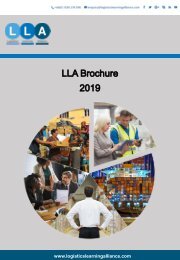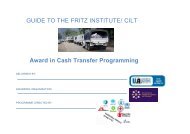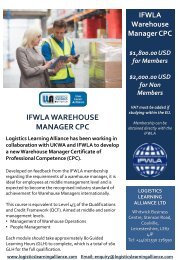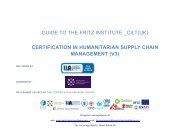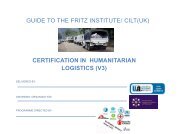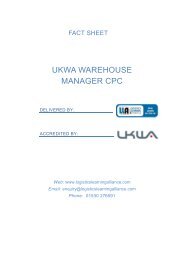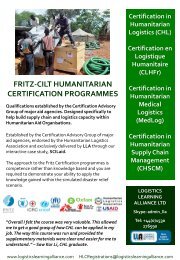CHSCM 3.0 - Unit 1 - SCM in the Humanitarian World
Learning Materials for Unit 1 of the Certification in Humanitarian Supply Chain Management (CHSCM).
Learning Materials for Unit 1 of the Certification in Humanitarian Supply Chain Management (CHSCM).
You also want an ePaper? Increase the reach of your titles
YUMPU automatically turns print PDFs into web optimized ePapers that Google loves.
The level of <strong>in</strong>ventory is represented by <strong>the</strong> water level <strong>in</strong> <strong>the</strong> tank. One tap controls <strong>the</strong> rate of<br />
<strong>in</strong>put or supply, and ano<strong>the</strong>r controls <strong>the</strong> rate of output or demand.<br />
If <strong>the</strong> demand tap is closed and <strong>the</strong> supply tap open, gradually <strong>the</strong> level of <strong>in</strong>ventory will<br />
decrease until <strong>the</strong>re is none left.<br />
If we turn <strong>the</strong> supply tap is closed and <strong>the</strong> demand open, <strong>in</strong>ventory will <strong>in</strong>crease until it<br />
overflows or, effectively, <strong>the</strong> tank bursts.<br />
If <strong>the</strong> rate of supply is synchronized with <strong>the</strong> rate of demand, <strong>the</strong> <strong>in</strong>ventory level will rema<strong>in</strong><br />
<strong>the</strong> same. Indeed, if this were <strong>the</strong> case <strong>the</strong> need for any <strong>in</strong>ventory could be questioned.<br />
With no <strong>in</strong>ventory <strong>in</strong> <strong>the</strong> tank, product would flow straight through from supply to demand.<br />
In o<strong>the</strong>r words, it would become like a pipel<strong>in</strong>e.<br />
This concept of a pipel<strong>in</strong>e will become helpful later on; it represents <strong>the</strong> utopia of all supply cha<strong>in</strong><br />
managers.<br />
The amount of <strong>in</strong>ventory that is held <strong>in</strong> <strong>the</strong> supply cha<strong>in</strong> is <strong>the</strong> result of how well it is managed. It will<br />
affect how quickly products move through <strong>the</strong> entire cha<strong>in</strong>. This, <strong>in</strong> turn, will reflect how fresh or<br />
new <strong>the</strong> product is when it reaches <strong>the</strong> beneficiaries. Additionally, <strong>the</strong> amount of <strong>in</strong>ventory held also<br />
impacts <strong>the</strong> f<strong>in</strong>ance required to operate <strong>the</strong> supply cha<strong>in</strong>.<br />
The primary structure of <strong>the</strong> supply cha<strong>in</strong> is created by <strong>the</strong> process<strong>in</strong>g and storage facilities. To<br />
enable products to flow from <strong>the</strong> supply po<strong>in</strong>t of <strong>the</strong> cha<strong>in</strong> to <strong>the</strong> demand po<strong>in</strong>t, <strong>the</strong> different<br />
facilities must be l<strong>in</strong>ked. These l<strong>in</strong>ks are provided by <strong>the</strong> modes of transportation. They <strong>in</strong>clude<br />
roads, railways, waterways, sea lanes, air lanes, and pipel<strong>in</strong>es.<br />
Each mode of transportation offers a comb<strong>in</strong>ation of speed, cost, and reliability. In addition, each<br />
has a different ability to handle volume, weight, and physical characteristics of products.<br />
Sometimes it will be necessary to comb<strong>in</strong>e several modes of transportation to be able to move<br />
product between two supply cha<strong>in</strong> facilities. This is referred to move as <strong>in</strong>ter-modal or multi-modal<br />
transport.<br />
So far, we have seen that a supply cha<strong>in</strong> consists of facilities owned by different participants that<br />
perform process cycles, that create different formats of <strong>in</strong>ventory, and that are connected by<br />
transportation l<strong>in</strong>ks.<br />
The task of <strong>the</strong> supply cha<strong>in</strong> manager is to f<strong>in</strong>d a way to manage <strong>the</strong> flow of goods to <strong>the</strong><br />
beneficiaries. In do<strong>in</strong>g so, <strong>the</strong>re are two goals that must be met. First, <strong>the</strong> requirements of <strong>the</strong><br />
beneficiaries must be satisfied and, second, <strong>the</strong> activities must be performed at a cost that is<br />
acceptable to <strong>the</strong> supply cha<strong>in</strong> participants. The ability to achieve <strong>the</strong>se goals will depend on how<br />
well <strong>the</strong> supply cha<strong>in</strong> flows are managed.




